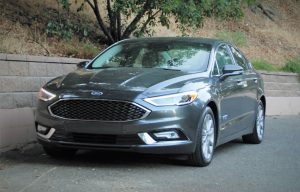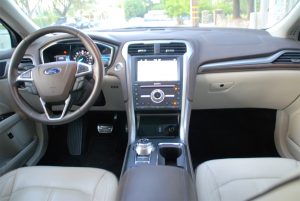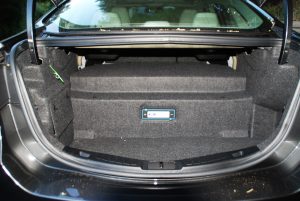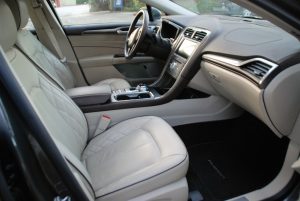A Practical, Functional Plug-in Choice
Let’s get the disclosures up front on this. I like the Ford Fusion Energi enough that I’m putting my own money into a lease on a 2016 model already. So to say I’m predisposed positively to a look at the 2017 Ford Fusion Energi is a given. That said, I’m also aware of the shortcomings of the car from extensive experience.

The key question for this review is what changes the 2017 model offers compared to the previously solid offering. The answer is—not much, which is a good thing. Ford appears to be sticking with its winning hand. Winning as in its non-plug-in hybrid version that has challenged the venerable Toyota Prius for the sales lead of hybrids during 2017. The plug-in Fusion has not had as strong of a year, though it’s still a strong third after the Toyota Prius Prime and Chevrolet Volt in the plug-in hybrid category.
The Good
The 2017 Ford Fusion Energi is, to my eye, one of the best-looking mass market sedans available. The current design was stunning when it first appeared in 2013 and still looks fresh today. It’s due for a change soon, but for now this midsize sedan can hold its own style-wise with anyone in the pack.

The car delivers fuel economy as advertised, but the 2017 model bumps up the numbers from the previous year by about 10 percent. If you’ve got a short commute of about 20 miles and a place to plug in at home and work, you could run all-electric all the time. It continues to be eligible for a coveted solo HOV lane sticker in California. It also qualifies for federal tax credits and most state incentives.
The interior of the Fusion matches the upscale exterior. Leather trimmed, comfortable, but supporting seats are standard throughout the line. Technology abounds from Ford’s Sync 3 infotainment system to available advanced driver assistance tools like lane-departure warning, adaptive cruise control, blind spot detection and cross traffic alert.
The Bad
The 2017 Ford Fusion Energi is not a purpose-build vehicle and all you have to do is look in the trunk to see that. What should be a spacious storage space is gobbled up by the 7.6 kWh lithium-ion battery. Next generation this should be solved, but the current models have spacious interiors for five adults, but are challenged in trying to carry luggage for more than a couple passengers.

Even at 22 miles (in the 2017 model), all-electric range is not the Energi’s strong suit. The relatively small battery can be charged in 2 ½ hours (on 240-volt, Level 2 charging), but if you travel like I do, you’ll be running in hybrid mode most of the time (still not bad at 43 mpg).
The Ugly
Sorry, I’m coming up blank in this category for this car, except maybe pricing. The MSRP for the Energi has been stable over the years and even dropped for 2017. It starts at just above $32,000 and tops out with the Platinum model I tested at just a shade under $40,000. I’d recommend going for the high-end model because it has all of the advanced technology standard (it’s optional at the lower levels, but will then take the price up almost to the Platinum level. In addition, I’d recommend leasing rather than buying the Energi—or virtually any plug-in model. Technology is advancing so rapidly that even it is isn’t cheaper in three or four years, it will be much better for the same money.
The Real World Test
It shouldn’t surprise anyone that the Fusion is Ford’s best-selling car. Besides being good-looking, it’s functional (with plenty of room for passengers at least) and delivers good performance and great fuel economy.

After spending time in smaller all-electric or plug-in sedans, the 2017 Ford Fusion Energi feels positively spacious. You can fill it up with five full-size American adults and not feel cramped (remember my caveat if they’re bringing luggage, though).
On the road, the car drives as good as it looks. Ford continues to respect its drivers by giving them good road feel, responsive and supple handling and enough power to hold their own on the open road. The long wheelbase of the Fusion helps deliver a luxury-like ride while the low-profile 17-inch tires and aluminum wheels (upgradable to 18-inchers) allow you to tackle challenging roads without disclosing you’re driving a fuel-efficient vehicle.
The 2-liter Atkinson-cycle inline-four is augmented by an electric motor and they operate quite well together, straining only when asked to perform high-speed passing tricks. Such maneuvers point out the limitations of this size normally aspirated engine and also its continuously variable transmission. It gets the job done, but will let you know it’s not happy.
I plugged in the Fusion whenever I could (I don’t have a home/work charger but there is one in the neighborhood) and managed an average of 53.2 mpg for my week in the car. EPA says you’ll get an average of 42 mpg in hybrid mode and 97 MPGe counting the battery energy. That wonkish number doesn’t mean much in the real world, where you can run 22 miles on electricity and then default to hybrid mode unless you plug in. I still found when handled with a light foot, the Fusion was capable of running at freeway speeds with the air on and still delivering almost 50 mpg.
Some of the credit for good fuel economy goes to Ford’s instrument panel programmers. The readouts for fuel economy, braking, etc., are great teaching tools. The instant feedback from driving in an eco-friendly mode was good reinforcement.
Bottom Line
I’ve got to say Ford just keeps making the Fusion better. It’s not perfect, but it’s an incredibly fuel-efficient car you can live with every day. Most important is because of its internal combustion engine, it doesn’t have the limitations of most pure electrics.

Here are the price points for the three trim levels (I recommend aiming high because all of the advanced technology you want is included), including destination and delivery charges:
- 2017 Ford Fusion Energi SE $32.180
- 2017 Ford Fusion Energi Titanium $33,180
- 2017 Ford Fusion Energi Platinum $40,180
A full complement of safety equipment is standard, but as mentioned earlier, some of the advanced driver assistance technology is optional on the lower trim levels. Opt for the Platinum level and the only options left are some paint and floor mat upgrades.

The 2017 Ford Fusion Energi is not alone in the marketplace. Its main competitors are the Chevrolet Volt, Toyota Prius Prime and the Hyundai-Kia twins—the Optima and Sonata Plug-in Hybrids.
All are worth a look, but you’ll find the Chevy is a smaller package and a hatchback. The Toyota also is smaller, though it does bring Toyota’s solid reputation along with its badge. The midsize Optima and Sonata are the closest in size and intent. We’ve tested them both here and here, but recommend you take a look for yourself. There are no bad choices among this group—and expect more coming soon.
Related Stories You Might Enjoy:
Road Test: 2017 Chevrolet Volt
Road Test: 2017 Toyota Prius Prime
Comparison Test: 2017 Ford Fusion Hybrid & Eneergi
Road Test: 2017 Hyundai Sonata Plug-in Hybrid
Comparison Test: 2016 Kia Optima Plug-in Hybrid & Hybrid
Disclosure:
Clean Fleet Report is loaned free test vehicles from automakers to evaluate, typically for a week at a time. Our road tests are based on this one-week drive of a new vehicle. Because of this we don’t address issues such as long-term reliability or total cost of ownership. In addition, we are often invited to manufacturer events highlighting new vehicles or technology. As part of these events we may be offered free transportation, lodging or meals. We do our best to present our unvarnished evaluations of vehicles and news irrespective of these inducements.
Our focus is on vehicles that offer the best fuel economy in their class, which leads us to emphasize electric cars, plug-in hybrids, hybrids and diesels. We also feature those efficient gas-powered vehicles that are among the top mpg vehicles in their class. In addition, we aim to offer reviews and news on advanced technology and the alternative fuel vehicle market. We welcome any feedback from vehicle owners and are dedicated to providing a forum for alternative viewpoints. Please let us know your views at publisher@cleanfleetreport.com.

5 thoughts on “Flash Drive: 2017 Ford Fusion Energi”